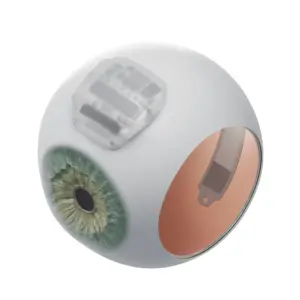Science Corp. has developed a cutting-edge optogenetic visual prosthesis called FlexLED that utilizes MicroLED technology. The device combines a thin-film retinal display with targeted activation of retinal ganglion cells (RGCs) to restore vision in individuals suffering from photoreceptor degeneration due to conditions like retinitis pigmentosa and macular degeneration.

The FlexLED is a flexible, wireless device that is only 30 µm thin, containing 8,192 pixels, each emitting light from an area of 66 µm². The technology is designed to allow the brain to convert the light gathered by the device into sight, effectively turning RGCs into photoreceptive cells. Optical stimulation of the retina using the FlexLED has already shown promise in rabbit models, eliciting activity in the visual cortex.
The FlexLED requires a specific wavelength of light, which is provided by camera-affixed glasses wirelessly sending information to the device. Science Corp. says the technology can scale to hundreds of thousands of pixels, allowing for the potential development of an implantable optogenetic visual prosthesis capable of generating vision by stimulating RGCs at near-cellular resolution. The device is designed to restore vision in individuals with photoreceptor degeneration, and it’s based on a combination of a thin-film retinal display and the activation of retinal ganglion cells (RGCs).
FlexLED is a MicroLED device that measures only .03mm thin and is flexible, wireless, and contains over 8,000 pixels. The device is affixed to the back surface of the eye, while the accompanying electronics package is mounted on top of the eye, similar to existing glaucoma drainage implants.
The FlexLED gathers light and, with targeted activation of the RGCs, allows the brain to convert that light into sight. In testing, the technology appears to work, successfully turning RGCs into photoreceptive cells and lighting up the brain. While testing with human cells is tricky, the team has started growing a retina to test the plan and has enlisted the help of rabbits to demonstrate the technology’s effectiveness.
In rabbit models, optical stimulation of the retina using the FlexLED elicits activity in the visual cortex, indicating promising results. Science Corp. says the technology can scale to “hundreds of thousands of pixels, providing a route toward an implantable optogenetic visual prosthesis capable of generating vision by stimulating RGCs at near-cellular resolution.” The FlexLED requires a specific wavelength of light, so Science Corp. has developed camera-affixed glasses that wirelessly send information to the device to bring that pixel power to play.
However, the data in the study published in the paper reference below does not directly address whether the device can restore any degree of visual perception. The study found that the FlexLED device can elicit activity in the visual cortex of rabbit models with photoreceptor degeneration, indicating potential for visual perception restoration. However, the recordings were performed under general anesthesia, raising questions about the technology’s effectiveness in awake, behaving animals.
To address these concerns, additional experiments are needed, such as those using recording techniques with single-cell resolution and testing the technology in foveated animals performing psychophysical behavior during electrophysiological recordings. These experiments will help determine the functional resolution and bitrate of the optogenetic implants.
Furthermore, the study highlights the need to address device longevity and performance for chronic implantation. Although there are still challenges to overcome, the FlexLED optogenetic visual prosthesis presents a proof-of-concept approach to restoring vision by controlling most of the retinal ganglion cells in a human eye at near-cellular resolution. Despite the unanswered questions and challenges, the potential of the FlexLED optogenetic visual prosthesis is undeniable. As Science Corp. moves forward with in-human clinical studies, this technology could provide new hope for individuals suffering from photoreceptor degeneration.
Reference
Knudsen, E. B., Zappitelli, K., Brown, J., Reeder, J., Smith, K. S., Rostov, M., Choi, J., Rochford, A., Slager, N., Miura, S. K., Rodgers, K., Reed, A., Israeli, Y. R. L., Shiraga, S., Seo, K. J., Wolin, C., Dawson, P., Eltaeb, M., Dasgupta, A., … Hodak, M. (2023). A thin-film optogenetic visual prosthesis (p. 2023.01.31.526482). bioRxiv. https://doi.org/10.1101/2023.01.31.526482

